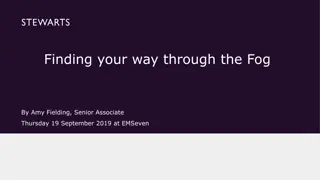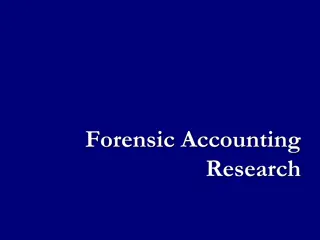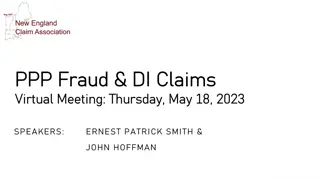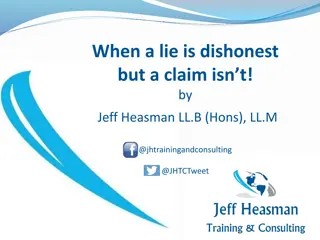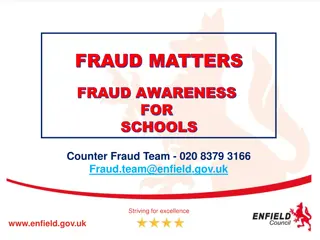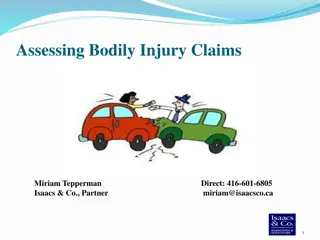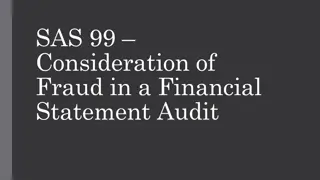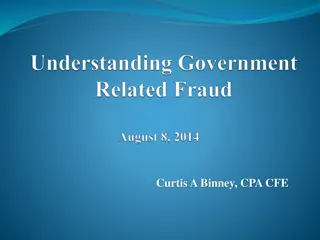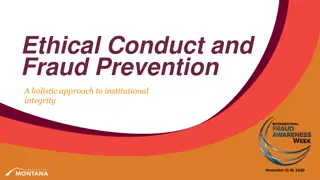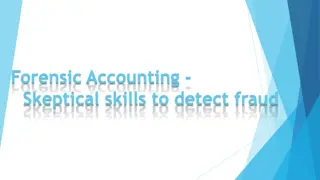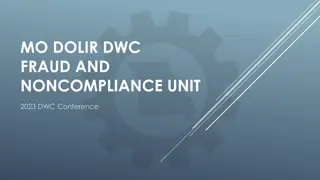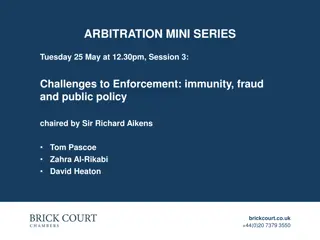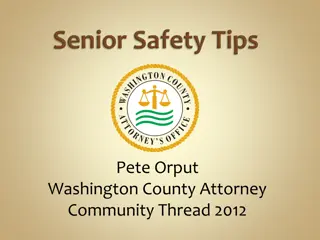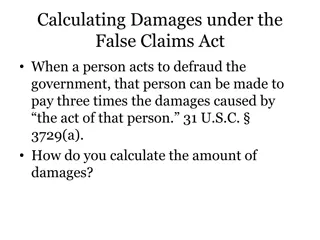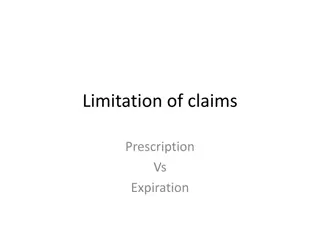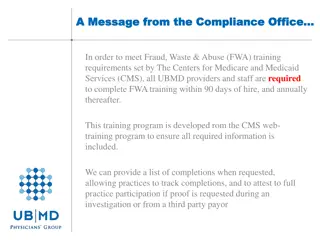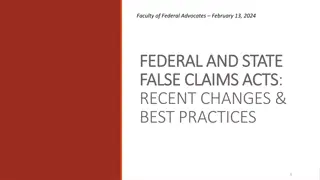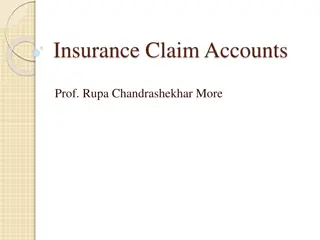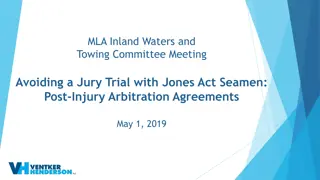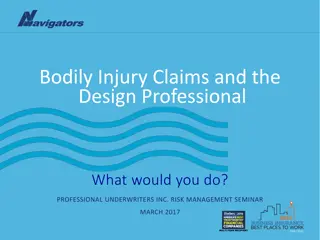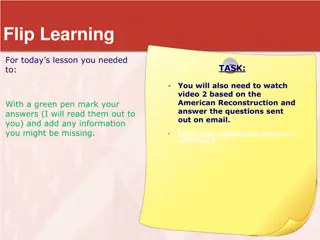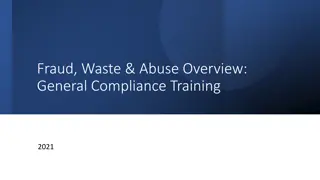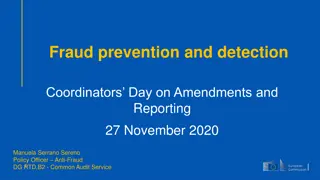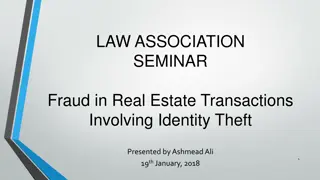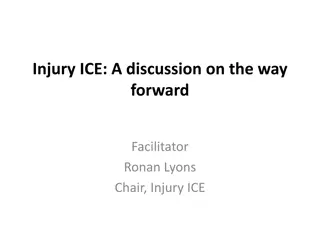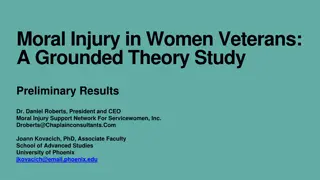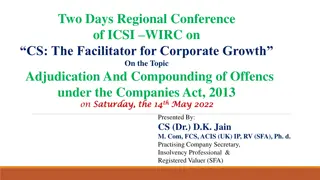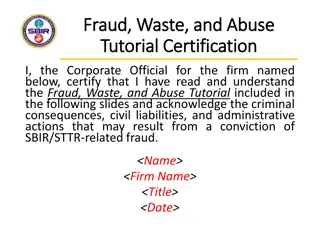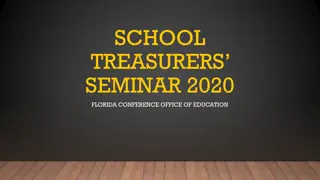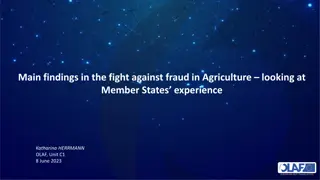Understanding Fraud and Fundamental Dishonesty in Personal Injury Claims
Fraud and fundamental dishonesty continue to be pressing issues in personal injury claims, with an increase in fraudulent activities being observed. This article discusses the rise of fraud, recent reforms in the civil justice system, instances of strike out for abuse of process, the introduction of Qualified One-Way Costs Shifting (QOCS), and the implications of fundamental dishonesty on claimants and the QOCS shield.
Download Presentation

Please find below an Image/Link to download the presentation.
The content on the website is provided AS IS for your information and personal use only. It may not be sold, licensed, or shared on other websites without obtaining consent from the author. Download presentation by click this link. If you encounter any issues during the download, it is possible that the publisher has removed the file from their server.
E N D
Presentation Transcript
Fraud and Fundamental Dishonesty in personal injury claims Louise Bland Partner Ellisons 11thOctober 2016
Introduction Fraud is forever on the increase Historically apathetic and ineffectual civil justice system Recent years have seen welcome reforms.
Strike out for abuse of process CPR3.4(2)(b) Summers v Fairclough Homes Ltd (2012) D s insurer was suspicious of Summers injury and obtained surveillance which showed he had seriously exaggerated his symptoms. Original schedule pleaded losses of 838k At trial Summers was awarded 88k (approx. 10% of original schedule) D applied to have the case struck out in it s entirety at the end of trial for abuse of process.
Strike out for abuse of process Supreme Court: A court does have the power to strike out a statement of case for abuse for process even after trial and where it has been able to make a proper assessment of both liability and quantum. Circumstances in which a court would do this were very exceptional and only where it was just and proportionate to do so. On the facts it was not appropriate to strike out.
Strike out for abuse of process Fari v Homes for Haringey (2012) unreported. C claimed damages in excess of 740k Liability admitted. Surveillance was obtained. Both parties experts agreed that C had significantly exaggerated her injuries. The true value was assessed as 1500. Only appropriate order was to strike out.
Qualified one way costs shifting (QOCS) CPR 44.13 44.16 introduced April 2013 An unsuccessful Claimant in a personal injury claim is not liable for the Defendant's costs. Exceptions D may enforce an order for costs: to the extent of damages and interest where a C fails to beat a Part 36 offer. to their full extent where proceedings are an abuse of process. with permission to their full extent where the claim is found to be fundamentally dishonest .
Fundamental Dishonesty CPR 44.16 (1) the shield of QOCS is lost where the claim is found to be fundamentally dishonest CPR 44 PD 12.4 when and how the court can make a finding of fundamental dishonesty.
CPR 44 PD 12.4 a) The court will normally direct that an allegation of fundamental dishonesty be determined at trial. b) where proceedings have been settled, the court will not, save in exceptional circumstances, order that an allegation that the claim was fundamentally dishonest be determined.
CPR 44 PD 12.4 c) Where the claimant has served a notice of discontinuance, the court may direct that an allegation that the claim was fundamentally dishonest be determined. d) The Court may as it thinks fair and just, determine the costs attributable to the claim having been found to be fundamentally dishonest.
Fundamental Dishonesty what does it mean under CPR? Gosling v Hailo (1) Screwfix Direct (2) 29/3/14 Cambridge County Court unreported. C suffered a knee injury involving a ladder made by D1 and sold by D2. The Defendants obtained surveillance showing C shopping without the aid of a crutch. Later the same day he attended a medico legal appointment using a crutch and complaining of constant pain and an inability to shop! C settled with D1 for reduced damages and discontinued against D2.
CPR 44.16 Fundamental dishonesty D2 applied successfully under CPR 44.16: Fundamental dishonesty must be interpreted purposefully and in the context of the claim (does this C deserve QCOS protection?) Incidental/collateral dishonesty is not fundamental. The dishonesty must go to the root of the whole claim or a substantial part of the claim. C s dishonesty destroyed 50% of his claim s value and that was sufficient for a finding of fundamental dishonesty.
CPR 44.16 Fundamental dishonesty Zimi v London Bus Co Ltd Central London County Court 8/1/15 C claimed D s bus encroached into his lane and struck his car from the rear. D adduced CCTV showing no such collision. Minor scuffs to C s vehicle were inconsistent with alleged collision. In cross examination C accepted he told his GP a short time after the accident that he was well. C misled medico legal experts.
CPR 44.16 Fundamental dishonesty Court found that there was no collision. Claim dismissed. D applied for a finding of fundamental dishonesty. As in Gosling the Judge found that there must be conduct that goes to the base or core of the claim something of central and crucial importance. The C can not have been mistaken about the presence of a collision, he could not have had an honest belief in the basis of his claim on liability.
Creech v Severn Valley Railway March 15 C tripped over matting left after disassembly of an ice rink on the station concourse. D said at the time of the accident the ice rink still covered the concourse. the claim was dismissed and D successfully applied for a finding of fundamental dishonesty (fraud had not been pleaded). Finding was based on the impossibility of the C having an honest belief in the version of events that formed the basis of the entire claim.
Is an unsuccessful claimant always dishonest? Meadows v La Tasca 10 August 2016 C claimed she had fallen in the D s restaurant and suffered injury. District judge said that the C s evidence and that of her dining partner was riddled with inconsistencies in the mechanics of the fall, location and what was said in the immediate aftermath. It is difficult to see how this is not a dishonest claim
Meadows v La Tasca cont.. On appeal HHJ Hodge said fundamental dishonesty required something going to the root of the matter and took the view that: inconsistencies and curiosities highlighted by the judge did not entitle him to find that the claim had been fabricated and it was fundamentally dishonest .
S 57 Criminal Justice and Courts Act 2015 Addresses exaggerated claims where the Claimant has been fundamentally dishonest. Applies to cases issued after 15 April 2015. A separate and distinct regime that affects damages instead of costs.
S57 Criminal Justice and Courts Act: S57(1) where: a) the Court finds the C is entitled to damages in respect of the claim BUT b) on application by D for dismissal of the claim, the court is satisfied that the C has been fundamentally dishonest in relation to the primary claim or a related claim. The court must dismiss the primary claim, unless it is satisfied that the C would suffer substantial injustice if the claim were dismissed (s 57(2)).
S57 Criminal Justice and Courts Act: The duty to dismiss the claim includes the honest elements - S57(3). The Court order dismissing the claim must record the amount of damages that would have been awarded to the Claimant (the notional damages) - S57(4). The C will be ordered to pay the D s costs but the court must deduct the notional damages from the amount which the C has to pay in respect of the D s costs S57(5).
S57 Example C seriously exaggerates symptoms and claim originally pleaded at 838k is assessed at 88k (Summers). Court is satisfied C has been fundamentally dishonest. D s costs are 100k. Effect of S57: C gets no damages. D recovers costs of 12k from C (having given credit for notional damage of 88k).
S57 cases Hanif v Patel May 2016 Court assessed C s damages at 1425 but dismissed the entire claim where the C had served a statement from a witness who was not actually at the scene of the accident. Shahid v Puddick Sept 16 A claim was made by 3 C s but only one was in the car and had a genuine claim. The Court struck out the genuine claim because the C had supported the false claims.
OVERVIEW STRIKE OUT FOR ABUSE OF PROCESS S57 STRIKE OUT CPR 44.16 DISSAPPLY QCOS Entire claim struck out Entire claim struck out Usually where claim is dismissed C gets no damages C gets no damages If above, C gets no damages D gets costs in full D gets limited costs D gets costs in full Hardest to get: very exceptional circumstances C must have been fundamentally dishonest The claim must have been fundamentally dishonest
Beyond the claim itself Contempt of Court: Proceedings for contempt of Court may be brought against a person if he makes a false statement of truth (CPR 32.14(1)) or a false disclosure statement (CPR 31.23(1)) without an honest belief in it s truth. Application for permission to the (High Court) Judge is required.
Contempt of Court Burden of proof on applicant is to the criminal standard i.e. beyond a reasonable doubt. Ingredients: Falsity of the statement Statement has/would have interfered with the course of justice in some material aspect At the time it was made the maker had no honest belief in the truth of the statement and knew of it s likelihood to interfere with the course of justice. Penalties: Up to 2 years imprisonment or an unlimited fine (most go to prison).
Contempt of Court Brighton and Hove Bus & Coach Ltd v Brooks (1) Tadrous (2) Tadrous (3). C knocked down by D s bus Suffered TBI remained in hospital for 6 weeks Statements made by family regarding C s mobility markedly contradicted surveillance C attended medico legal examinations with D1 (daughter) and D3 (husband) with zimmer frames/wheechairs and represented that her mobility was severely restricted. Surveillance on same day showed her walking for 76 minutes without any apparent difficulty.
Contempt C accepted low Part 36 of 40k Permission granted for contempt proceedings against all three. Daughter and Husband convicted of contempt. Homes for Haringey v Fari and Fari C tripped over paving slab suffered knee injury. Attended medical examinations with stick and considerable help from husband. Spent next two days shopping and walking freely. Damages assessed at 1500 against 740k schedule C imprisoned for 3 months, husband 2 month sentence suspended for 12 months.
Private prosecution Fraud Act 2006 A person is guilty of fraud if he dishonestly makes a false representation for gain for himself or another or to cause loss to another. A representation is false if it is false/misleading. A representation my be express or implied.
Private prosecution Service Insurance Co Ltd: Pursued prosecutions against 21 fraudsters, 19 on bus, 2 in car. Pre planned incident to make fraudulent claims worth 140k. CCTV showed car struggling to keep up with bus and accelerating in order to hit it and passengers indicating to each other and jumping up holding necks. 19 Defendants received sentences of 12 -21ms. Insurer awarded costs of bringing the claim.
Tort of Deceit A tort (a wrong) arising out of a false statement of fact made by one person, knowingly or recklessly with the intention it should be acted upon by another who suffers damage as a result.
Tort of Deceit Akhtar (1) Khan (2) v Ball Walsall County Court 10/7/15 Akhtar deliberately applied her brakes to induce Miss Ball to collide with her vehicle with the aim of recovering compensation. Included a claim for Khan who was not event in the vehicle. Judge found no injury but said that even if he had he would have considered it appropriate to strike out for abuse of process following Summers. Court made a finding of fundamental dishonesty pursuant to CPR44.16 and disapplied QOCS. Also allowed D s counterclaim for damages for deceit for which the judge allowed 3,000.
Hayward v Zurich Insurance Co Plc August 2016 Facts: Mr H made a claim for 420k for a back injury he suffered at work in 1998 for which liability was accepted. Complained that his injuries caused him serious lumbar pain restricting his mobility and ability to work. D obtained surveillance showing he was exaggerating his symptoms and made an offer of 135k. C accepted offer in 2003.
Hayward v Zurich Insurance Co Plc Five years later In 2009 Zurich obtained further surveillance on the C and evidence showing that he had not only exaggerated the extent of his injuries but fully recovered one year prior to settlement. Zurich commenced proceedings against C for damages for deceit equivalent to the difference between the settlement sum and true value of the claim/have the settlement set aside.
Hayward v Zurich Insurance Co Plc At first instance the Court said the settlement should be set aside and repaid. On appeal, CA said Zurich had pleaded fraud and therefore this issue had been compromised as part of the settlement. Supreme Court set aside the settlement and said C should be awarded the reduced sum of 14,720. Zurich did not have to show that they believed C for the purposes of misrepresentation, rather that it induced Zurich to settle to mitigate the risk that C might have been believed at trial.
Hayward v Zurich Insurance Co Plc Policy considerations: Finality of settlements -v- allowing a C to benefit from his fraud. Fraud trumps settlement!


